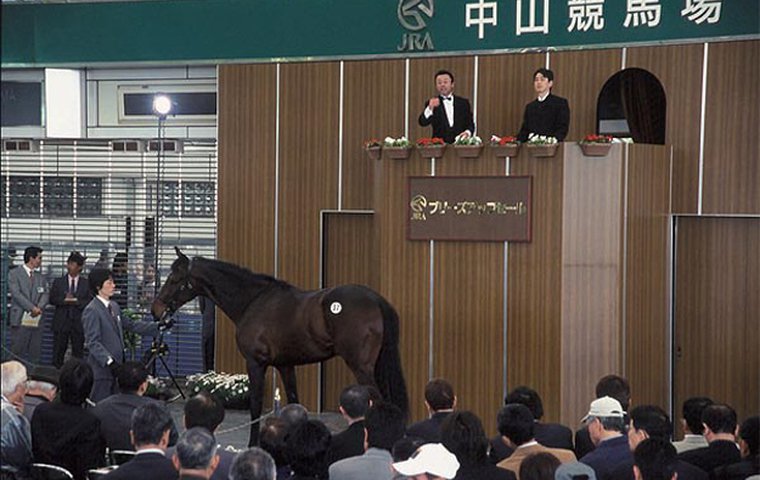
In Part 2 of his assessment of the health of Japanese racing, Naohiro Goda noted the small but significant rise in overall betting turnover, the first meaningful increase, if one discounts the year of recovery after the Fukushima disaster in 2011, since the peak year of 1997. In his conclusion, he looks at the future of racing and of the breeding industry.
-----------
As 2014 proceeds, there is continued reason for optimism in Japanese racing. The top end of the breeding industry is prosperous, and the Japan Racing Association (JRA) can expect increased turnover figures, if a plan outlined in Chairman Kenji Tsuchikawa’s New Year statement comes to fruition. At the moment, Japanese law states that the JRA can organize betting only on races held in Japan, not on those held overseas. But chairman Tsuchikawa said he is keen to organize wagering on horse racing abroad in 2014, beginning with races in which there are Japanese-trained runners, which would be the first step.
Any relaxation of the law would certainly provide a substantial boost to turnover. In 2013, for example, the Prix de l’Arc de Triomphe, in which Orfevre and Kizuna ran, and the Hong Kong Sprint, which Lord Kanaloa won for the second time, attracted great public interest among Japanese racing fans even though they were not allowed to bet on them. The amount that might have been bet on these two races alone if only betting had been permitted can only be guessed.
The current situation in the Japanese breeding industry is similar to those in the United States and Europe. The top end is very strong, while still very selective. The gross sale at the Japan Racing Horse Association (JRHA) Select Sale in July 2013 at Northern Horse Park, the premier market for young Japanese-bred Thoroughbreds, was ¥11.7 trillion ($110 billion), a 14.3 percent increase on the previous year, and a new record for the JRHA Sale that was inaugurated in 1998. The previous record came in 2006. In addition to local players, buyers from the Middle East and Australia were active and helped boost the market.
Top breeders are doing well. And after such a good sale, they have been able to afford to make further investment in well-bred mares. For example, Teruya Yoshida of Shadai Farm spent $6.45 million to secure four mares, and Katsumi Yoshida of Northern Farm spent $5.775 million to buy another four during a single session of the Fasig-Tipton Breeding Stock Sale on Nov. 4, 2013. Teruya Yoshida, owner of Shadai Farm and vice-chairman of the JRHA, has already stated that the JRHA catalogue in 2014 will be much better than 2013 in the expectation of an even stronger contingent of buyers from the Middle East, Australia, and Europe. And it is also hoped that buyers will also arrive from the U.S., something not yet seen at a JRHA Sale.
On the other hand, the market at the foal session of the Hidaka Horse Breeders Association (HBA) Autumn Sale on Oct. 7, 2013 at Shizunai was very slow. Only 7 foals out of 58 offered could find new owners, and the buy-back rate was high at 87.9 percent. The gross sale of ¥74.million represented a 28.7 percent drop on 2012, demonstrating the fact that medium and small breeders continue to struggle. Perhaps, the continuing slide in racecourse attendance at the lower level and rise in the major races is a relevant parallel.
With Orfevre having retired in a blaze of glory after his remarkable swansong in the Arima Kinen, Japanese racing is also in need a genuine star to replace him. Among the hottest hopes at the moment is Harp Star, a 2-year-old filly by Deep Impact and a Japan Derby entry for 2014. Harp Star was unbeaten in two starts so far; beating colts on her second outing, then went down by a head in a particularly strong field of fillies when slightly below par in her final start. However, she remains highly regarded. The dream would be for her, or perhaps another from the strong crop of Japanese fillies, to progress to success in the 2014 Prix de l’Arc de Triomphe, the race that remains the summit of ambition for all of us involved in racing and breeding in Japan.
So far, the Arc has frustrated us with Japanese-trained horses beaten into second place four times in the last 15 years. But three-year-old fillies have won the Arc three times in the last six years, and no Japanese-trained, three-year-old filly has tried it yet. Harp Star could be the one and if she is, the effect her triumph would have on the popularity of racing in Japan is simply incalculable.
If another charismatic champion were to emerge to supplement the work of the JRA in maintaining public interest in the face of challenges from other sports, especially soccer, and if the Japanese economy can emerge from the doldrums in which it has been becalmed for the last couple of decades, then horseracing in Japan can be expected to turn a corner and be ready to resume the upward progress that began in 1861. One grave concern remains though: a strong possibility that later this year the Abe government will pass a bill legalising casinos. If that happens then all bets about the long-term health of Japanese racing are off.
However, we should not forget that even as things stand, the status of the sport in Japanese society would be the envy of racing people in almost any other country of the world.
---
Naohiro Goda is a leading Japanese racing journalist and TV presenter, and an expert on the Japanese breeding industry.


